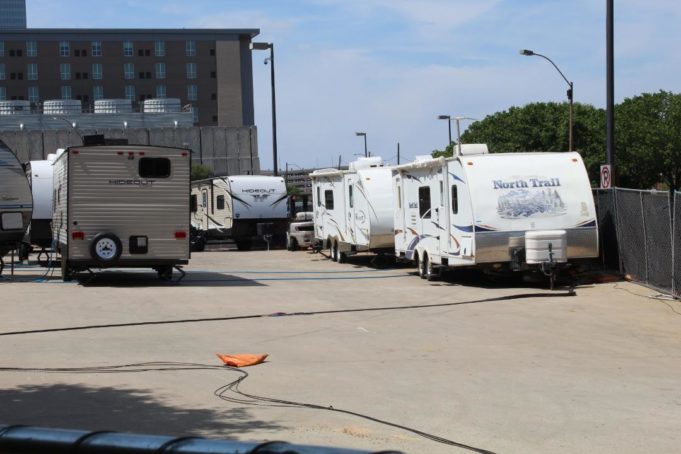Fort Worth’s homeless face two dire and potentially deadly risk factors for the COVID-19 disease. The chronically homeless are largely advanced in age, and they disproportionately suffer from chronic illnesses such as heart disease and diabetes, according to multiple officials we spoke with who are now providing that vulnerable population with sanitary shelter space, food, and daily medical care.
Federal guidelines released last March by the Centers for Disease Control and Prevention (CDC) outlined how homeless individuals should be housed to prevent the spread of COVID-19. Fort Worth’s homeless shelters were told that beds needed to be spaced 6 feet apart.
“That left 355 folks without a bed,” recalled Tara Perez, program manager for Directions Home, the city’s plan to address homelessness. She and her team worked with a large team of governmental groups, nonprofits, and JPS Health Network to provide emergency shelter inside the Fort Worth Convention Center.
Since opening on March 18, the temporary overflow shelter has housed 15,768 visitors with an average nightly occupancy of 329 guests, according to the city. To ensure homeless individuals outside the shelter systems are receiving help, the Tarrant County Homeless Coalition and JPS are tending to the needs of unsheltered individuals through outreach teams that provide COVID-19 screenings and hygiene supplies.
The main convention floor is now designated as a “wellness area,” said Bruce Frankel, executive director of the DRC (formerly Day Resource Center), a nonprofit that focuses on housing homeless individuals.
The emergency shelter operates daily from 4 p.m. to 7:30 a.m. All people who enter the building (guests and staff) are screened for symptoms of COVID-19 by JPS medical professionals.
“If you have no temperature, you are cleared to go and check in to a cot in the wellness center,” Frankel said. “If you do have a temperature, you are monitored in a secure area. If you appear to be sick, you are placed under observation for 14 days. If you are really sick, there are RVs in various areas that are secure where you can go for observation and testing.”
As of May 5, a city spokesperson said there is one person who is isolated for observation and no one is currently being isolated in an RV.
Anytime you have large groups of people gathered in one area, there’s an increased risk of spreading infections, Frankel said. Emergency shelter staffers provide guests with face masks. There are also sanitation stations readily accessible throughout the convention center.
After breakfast is served and homeless guests clear out for the day, Frankel said a crew thoroughly cleans every surface that someone may have come into physical contact with that day.
“We are working around the clock to keep the infection rates this low,” he said.
Perez said there hasn’t been an observed increase in the homeless population that can be traced to the COVID-19 outbreak. The economic fallout of the current crisis may take months to manifest as new numbers at homeless shelters. The county has not tracked the number of homeless people who have contracted COVID-19, according to Tarrant County Public Health.
The convention center is not a permanent solution. Perez said city officials are developing a plan to phase out the current emergency shelter as other housing/shelter options become available.
Perez said federal funds and new COVID-19-related federal funds will provide new resources for rapid rehousing efforts. If the CDC revises its spacing guidelines for beds in shelters, that may allow for the return of additional homeless individuals to other shelters like Presbyterian Night Shelter.
A city spokesperson said that city staffers are “working with the Tarrant County Homeless Coalition, along with other partners, to develop a safe and effective demobilization plan for the overflow shelter. Because of the fluid nature of this emergency, the plan is continually being reevaluated and adjusted. For now, we are continuing the operation as previously discussed.”
From what she has observed, Perez said, the city and county reacted quickly to protect the vulnerable homeless population.
“The city has a huge chain [of employees] working through our joint operation center,” she said. “To get everything in place with contracts, security, and food service, it was amazing how fast that was able to happen.”













I stayed at the convention center for two weeks.excellent job by everyone involved